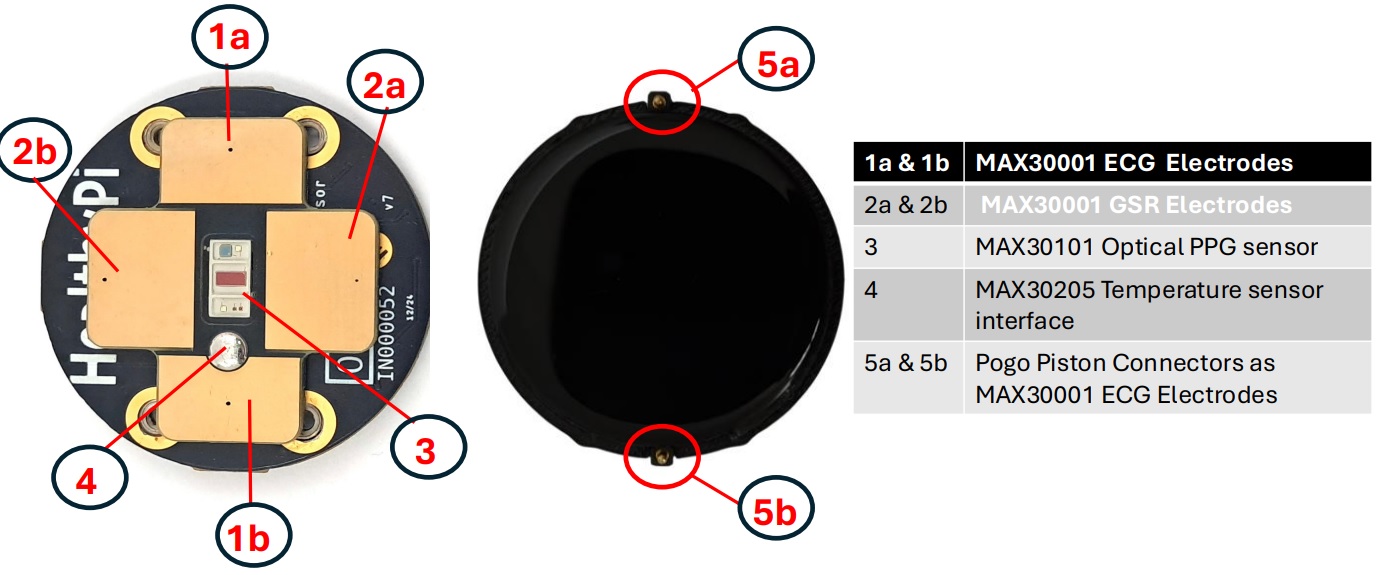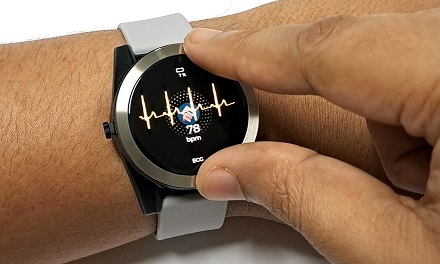Know your sensors
The Healthypi Move is equipped with a range of advanced sensors and sensor hubs, including:
- MAX30001 ECG and bio-impedance front-end
- MAX30101 Optical PPG Sensor
- MAX32664 Sensor Hub
- MAX86141 wrist PPG
- BMI323 6-DoF IMU
- MAX30205 Body Temperature Sensor

MAX30001 ECG and bio-impedance front-end
The MAX30001 is a single biopotential channel providing electrocardiogram (ECG) waveforms, heart rate and pacemaker edge detection, and a single bioimpedance channel capable of measuring respiration. The sensor interfaces for MAX30001 are strategically positioned on both the top and bottom of Healthypi Move main housing. The bottom section incorporates four gold-plated electrode pads, with the vertically aligned pads functioning as ECG electrodes ensuring accurate bio-signal acquisition.
Of the three electrodes required for ECG streaming, two leads are acquired through the vertically aligned gold-plated pads, while the third lead is obtained via piston pogo pin connectors. These connectors are located beneath the bezel, a stainless steel cover positioned on the top of the watch’s main body. The pogo pin connectors are arranged 180 degrees apart from each other.

MAX30101 Optical PPG Sensor
The MAX30101 is an integrated pulse oximetry and heartrate monitor module. It includes internal LEDs, photodetectors, optical elements, and low-noise electronics with ambient light rejection. The optical sensor is placed on the cutout between the four gold-plated, which consists of two photodiodes and four LEDs. This sensor serves as the analog front-end (AFE) for the MAX30101 Optical PPG Sensor, enabling precise photoplethysmography (PPG) measurements.
MAX86141 wrist PPG
The MAX86141 are ultra-low-power, completely integrated, optical data acquisition systems. On the transmitter side, the MAX86141 have three programmable high-current LED drivers that can be configured to drive up to six LEDs using an external 3x2:1 mux. On the receiver side, the MAX86141 has two optical readout channels that can operate simultaneously.
A key feature of the Healthypi Move is its ability to stream PPG from the finger is made possible by the MAXM86141 wrist PPG sensor, which is housed in an external cable. The sensor connects seamlessly to the Healthypi Move via the versatile USB Type-C port located on the side of the watch.
MAX30205 Body Temperature Sensor
The MAX30205 temperature sensor accurately measures temperature and provide an overtemperature alarm/interrupt/shutdown output. This device converts the temperature measurements to digital form using a highresolution, sigma-delta, analog-to-digital converter (ADC).
The front end for temperature sensor is present on the bottom of the main body of the watch. The round silver structure present just above the bottom gold-plated pad, acts as the analog AFE front end for the MAX30205 temperature sensor.
MAX32664 Sensor Hub
A key question is: How does the Healthypi Move calculate vital signs such as Heart Rate (HR), SpO₂, and Blood Pressure Trends (BPT)?
This is achieve through the MAX32664 sensor hubs, which integrate medical-grade PPG algorithm libraries. The MAX32664 is a sensor hub family with embedded firmware and world-class algorithms for wearables. It seamlessly enables customer-desired sensor functionality, including communication with Analog Devices' optical sensor solutions and delivering raw or calculated data to the outside world.
The Healthypi Move features two MAX32664 sensor hubs, each with a distinct role:
-
The MAX32664 Version D communicates with the MAX30101 to perform finger-based heart rate, blood oxygen saturation (SpO2), and blood pressure monitoring. T
-
The MAX32664 Version C communicates with the MAX86141 to perform wrist-based heart rate and blood oxygen saturation (SpO2) measurements.
BMI323 6-DoF IMU
The BMI323 is a highly integrated, low power inertial measurement unit (IMU) that combines acceleration and angular rate measurement with intelligent on-chip motion-triggered interrupt features.
The following diagram illustrates the data flow within the Healthypi Move, showcasing how sensors interact with sensor hubs to derive vital signs.
